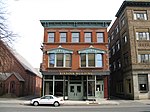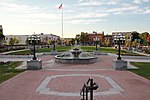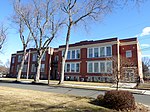Mechanic Street Cemetery

The Mechanic Street Cemetery is a historic early cemetery on Mechanic Street in Westfield, Massachusetts. The 4-acre (1.6 ha) cemetery is the city's oldest, with the oldest documented grave dating to 1683. It was used as a burying ground until the late 19th century, although its use began to decline in the middle of the century, with the advent of the popular rural cemetery movement, which was reflected in Westfield with the establishment of the new Pine Hill Cemetery in 1842. No burials were recorded in the 20th century. Although the cemetery has been subjected to some maintenance work, it continues to suffer the effects of vandalism and weather. The cemetery was listed on the National Register of Historic Places in 2002.
Excerpt from the Wikipedia article Mechanic Street Cemetery (License: CC BY-SA 3.0, Authors, Images).Mechanic Street Cemetery
Mechanic Street, Westfield
Geographical coordinates (GPS) Address Website External links Nearby Places Show on map
Geographical coordinates (GPS)
| Latitude | Longitude |
|---|---|
| N 42.123055555556 ° | E -72.744722222222 ° |
Address
Mechanic Street Cemetery (Old Westfield Burying Ground)
Mechanic Street
01085 Westfield
Massachusetts, United States
Open on Google Maps











